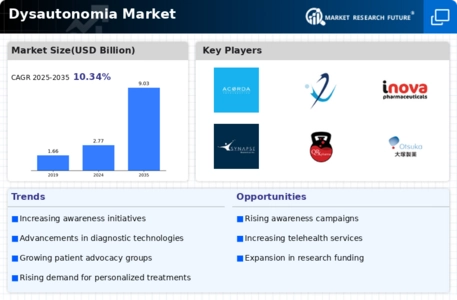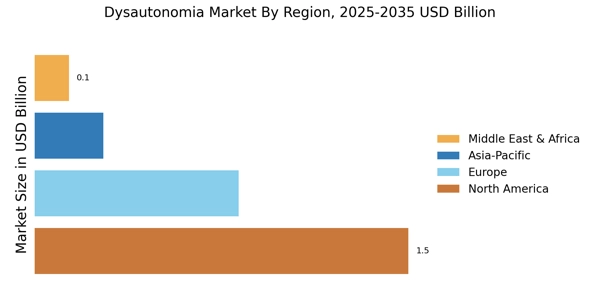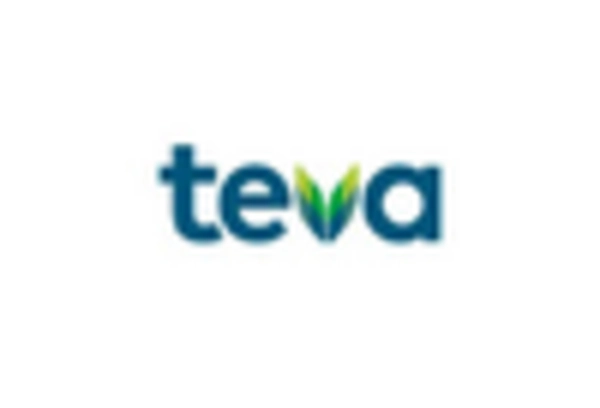Rising Prevalence of Dysautonomia
The increasing prevalence of dysautonomia is a notable driver in the Dysautonomia Market. Recent estimates suggest that approximately 1 in 100 individuals may be affected by some form of dysautonomia, indicating a substantial population that requires medical attention. This rising incidence is likely to spur demand for diagnostic tools and treatment options, thereby expanding the market. As awareness grows, healthcare providers are more frequently diagnosing dysautonomia, which may lead to an increase in patient referrals to specialists. Consequently, this trend could result in a more significant market share for companies focusing on dysautonomia treatments and management solutions. The Dysautonomia Market is thus positioned to experience growth as healthcare systems adapt to meet the needs of this expanding patient demographic.
Advancements in Diagnostic Technologies
Technological advancements in diagnostic tools are transforming the Dysautonomia Market. Innovations such as wearable devices and mobile health applications are enabling more accurate and timely diagnoses of dysautonomia. These technologies facilitate continuous monitoring of patients' vital signs, which can lead to earlier detection of symptoms. The integration of artificial intelligence in diagnostic processes is also enhancing the precision of assessments, potentially reducing the time to diagnosis. As a result, healthcare providers are likely to adopt these advanced technologies, which may increase the overall demand for dysautonomia-related services and products. The market could see a shift towards more personalized treatment plans, driven by data collected through these innovative diagnostic methods.
Emerging Treatment Options and Therapies
The emergence of new treatment options and therapies is reshaping the Dysautonomia Market. Recent developments in pharmacotherapy, including the introduction of novel medications, are providing patients with more effective management strategies. Additionally, non-pharmacological approaches, such as physical therapy and lifestyle modifications, are gaining traction as complementary treatments. The diversification of treatment modalities is likely to cater to the varying needs of patients, enhancing overall satisfaction and adherence to treatment plans. As healthcare providers become more aware of these emerging options, the market may witness an increase in the adoption of comprehensive care strategies. This trend could ultimately lead to improved patient outcomes and a more robust Dysautonomia Market.
Increased Patient Advocacy and Support Groups
The rise of patient advocacy and support groups is significantly influencing the Dysautonomia Market. These organizations play a vital role in raising awareness about dysautonomia, educating patients and healthcare professionals alike. By fostering community engagement, they help to destigmatize the condition and encourage individuals to seek medical help. This increased visibility may lead to higher diagnosis rates and, consequently, a greater demand for treatment options. Furthermore, advocacy groups often collaborate with researchers and healthcare providers to promote clinical trials and studies, which can enhance the understanding of dysautonomia. As these groups continue to grow, they are likely to drive market expansion by empowering patients and influencing healthcare policies.
Growing Investment in Research and Development
Investment in research and development is a critical driver for the Dysautonomia Market. Pharmaceutical companies and research institutions are increasingly allocating resources to explore new treatment modalities and therapies for dysautonomia. This focus on R&D is essential, as it may lead to the discovery of novel pharmacological agents and non-pharmacological interventions that can improve patient outcomes. Recent funding initiatives have been directed towards understanding the underlying mechanisms of dysautonomia, which could pave the way for targeted therapies. As more effective treatments emerge, the market is likely to expand, attracting both investors and healthcare providers interested in innovative solutions for managing dysautonomia.


















Leave a Comment